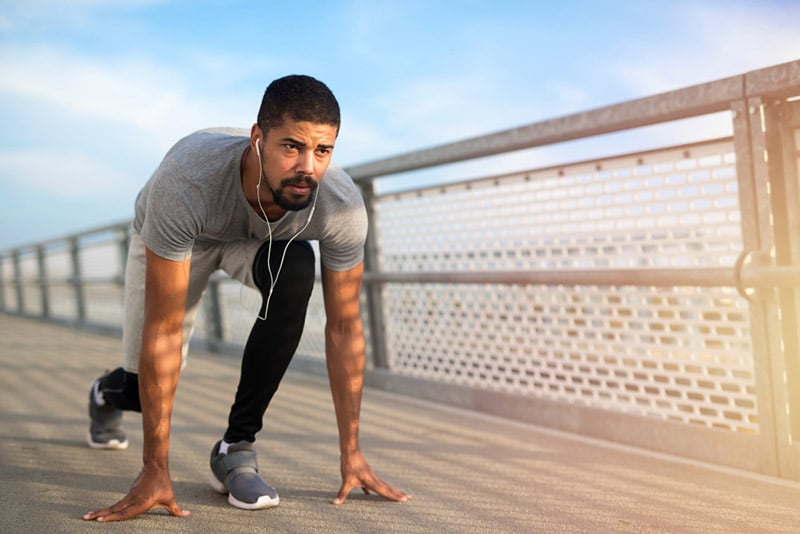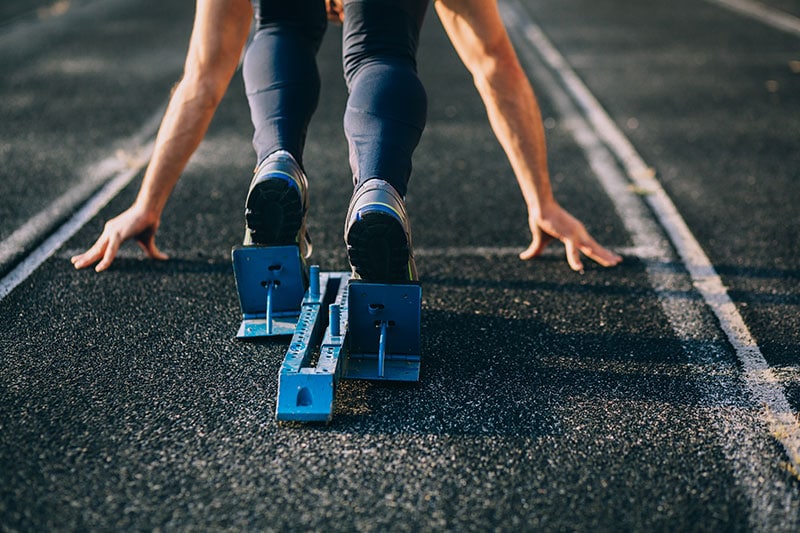If you’re looking to take your running to the next level, then adding some beginner sprinting workouts to your routine is a good option.
Sprinting is essentially just high intensity running in short intervals, which makes it a HIIT workout at the end of the day.
That means it’s a great way to level up your endurance, burn more calories, and get in some epic cardiovascular benefits.
And if you’re like me, the real benefit of sprinting is that it doesn’t take as long as say running a few miles a day.
Sound good?
Then let’s get you started with some tips and and resources for adding sprinting to your normal routine of resistance training and cardio workouts.
What is sprinting?
Sprinting is running for a short distance as your highest intensity level, which essentially means running full-force in short bursts.
This form of running pushes your body to the limit and builds both muscular and cardiovascular endurance.
It’s actually more of a workout for your body that road running.
ALSO READ: Getting Started With Road Running (Beginner’s Guide)

Benefits of sprinting
If you’re looking for a bit of motivation to actually do those sprints, then you should know that they are crazy good for your body.
Here are just some of the many benefits you can expect –
Increases anaerobic threshold
In case you’re not sure what your anaerobic threshold is, Polar.com describes it as the highest exercise intensity that you can sustain for a prolonged period without lactic acid substantially building up in your blood.
When you exceed your anaerobic threshold while working out and that lactic acid starts to build up, you will notice a distinct stiffness, and even slight burning sensation, in your muscles.
Personally, I also notice that I get more leg and muscle cramps when I’ve got too much lactic acid building up.
But, the more regularly you incorporate sprints into your workout routine, then then higher your anaerobic threshold becomes – and you definitely want that.
Increases your speed and strength
Since sprints are all about power, you will start to notice a boost in your strength and speed.
What’s great about this is that it carries over into other sports and workouts.
Improves overall athletic performance
As I just mentioned, doing sprints makes you better at all athletic activities – that’s why so many athletes incorporate them as part of their regular training.
Research shows that it only takes two weeks of sprint training to realize the gains in your overall athletic performance.
Preserves muscle mass
As we age, it seems almost a given that we will lose muscle mass – but wait just a minute…
According to the American Council on Exercise, sprints actually help counteract muscle loss as we age by preserving lean muscle.
ALSO READ: HIIT vs Running: Sprinting Benefits

How many sprints should a beginner do?
Regardless of your fitness level or athletic ability, when you start doing sprints it is something that you should slowly ease into your workout sessions.
HIIT activities, like sprints, are very demanding on the body and it is important that you focus on proper form when doing the fast paced movements,
For beginners, sprint for only around 10 seconds, and then take a 2-3 minute walk or break. Repeat this HIIT sprinting cycle for only 4-6 times to get started.
Once you get comfortable with six times of that cycle, you can work up to 10 cycles.
Is sprinting good for beginners?
Yes, sprinting is a great addition to your workout routine, even for beginners.
However, beginner do need some level of cardio or athletic ability before attempting to do sprints because some people simply may not be capable of running fast yet.
So, don’t worry when you start if you cannot go super fast or even if you cannot do very many cycles of sprints.
Just take it slow and focus on doing what you can.
To get started, try completing just three HIIT sprint cycles, even if it means you’re not going your fastest here at the beginning.
The nice thing about sprinting is that the more you do it, the better you get at it because your body is building up endurance.
And before you know it, you’ll not only be able to go faster and faster, but you’ll also be able to complete more reps of sprints.
How can I train myself to sprint?
As with all forms of exercise, the first thing to do when training to sprint is to start with warm-ups.
Since sprint is such a high intensity activity, it really works out a lot of muscles.
And you need those muscles to be nice and warmed up before you even attempt to do any sprints.
So, do some light stretches, leg drills like high knee lifts, and a moderate-level walk or jog to warm up those muscles.
Know that after you do your sprints, that your body will likely be sore for a day or two afterwards since you are stressing some new muscles that you may not have worked too hard prior to this.
The best way to deal with that muscle sores is to do those stretches and warm-ups both before and after your sprints. And, roll out your leg muscles when you’re done.
You’ll also want to find a safe, flat surface for your sprint training.
You shouldn’t try to do sprints on a treadmill, and instead focus on doing them on a track, gym, or other flat surface.
Try to avoid rocky surfaces or uneven terrain so that you don’t have to worry about obstacles while you’re trying to focus on training.
Remember to keep is slow at first – if you go too fast, too soon, then your max speed is low and that quickly lands you above your aerobic threshold, which means your body starts cycling lactic acid, which is hard to recover from.
Your form and your foot strike when sprinting are a bit different than when running.
When you need here is a forefoot strike instead of midfoot, which enables you to “peel through your toes so that you can use your hamstrings in a stride cycle.” (source)
Don’t try to do sprints daily because it can lead to that lactic acid buildup in your body, which is not ideal for anyone.
Beginner sprint workout
If you think you’re ready to add a regular beginner sprinting workout to your routine, then we have some sample workouts for you to consider.
Before we get started, remember that you should always start with a warm-up and close with a cool-down.
And, you don’t have to go “balls to the wall” right from the start – it’s okay, if not preferred, to start only going to 70% or 80% of your max instead of 100%.
Sample beginner sprinting workout –
- Warm-up: stretches and light jog/run for five minutes
- Sprint: go for 30 seconds at only around half of your max capacity.
- Slow: do a walk or jog for 60 to 120 seconds
- Sprint: go for 30 seconds, but this time at around 70% of your max capacity.
- Slow: do a walk or jog for 60 to 120 seconds
- Sprint: go for 30 seconds, but this time at around 80% of your max capacity.
- Slow: do a walk or jog for 60 to 120 seconds
- Repeat until a total of 10 – 12 minutes have passed.
- Cool down: stretches for five minutes and roll out your leg muscles
This should be enough of a workout to get you started as a total noob to sprinting.
As you gain more experience with sprints, you can increase the total amount of time for your workout, as well the amount of seconds you spend sprinting.
Just remember to not over-do it.
Sprinting FAQs
Below are some commonly asked questions about sprinting, along with their answers.
Do sprints burn belly fat?
Yes, sprints do burn belly fat.
According to the International Journal of Obesity, eight-second bursts of sprinting repeated intermittently for 20 minutes three times a week helped overweight men lose 4 pounds of body fat in 12 weeks and gain 2.64 pounds of muscle, resulting in a net body-weight loss.
Those men also experienced a 17-percent loss of visceral fat during the 12-week research period.
To achieve the same level of fat loss with only moderate jogging, it would require seven hours a week for a total of 14 weeks.
How will sprinting change my body?
Your legs and buttocks will get seriously toned from sprinting, with most of the changes noticeable in your quadriceps, hamstrings and glutes.
Since all of the muscles in your abdominal area must be be totally engaged for the duration of the sprint, you get some serious ab muscles from sprinting.
Your back, shoulders, arms and chest to develop a significant amount of muscle mass and become very strong from sprints.
Does sprinting build abs?
Yes, sprinting builds abs.
See the question above for more details on how sprints change and tone your body.
How long should I sprint to lose weight?
Aim for at least 20 minutes per week to see any noticeable weight loss.
Keep in mind that you’ll have to not only keep up the sprints, but increase them to continue seeing weight loss.
How many calories does sprinting burn?
Studies have shown that you can burn 200 calories with just two and a half minutes of maximum intensity sprinting.
This means when you go 100% with your sprints, this is the type of calorie burning that you can expect, on average.
Is sprinting good for your brain?
Yes, sprinting is good for your brain.
Research has shown that sprinting improves your memory and cognition.
It has also been shown to improve hormone imbalance.
Can sprinting replace leg day?
Yes, sprints can replace leg day for you.
This is because sprints give your legs a crazy awesome workout.
Is sprinting good for anxiety?
Yes, sprinting is good for anxiety.
Recent research shows that sprinting may be good for both improving depression and anxiety.
What should sprinters eat?
For the best results from your sprinting workouts, focus on getting some good protein.
Things like meats, eggs, fish, nuts, and beans are good choice for you.
Skip loading up on carbs if you’re doing sprints.
